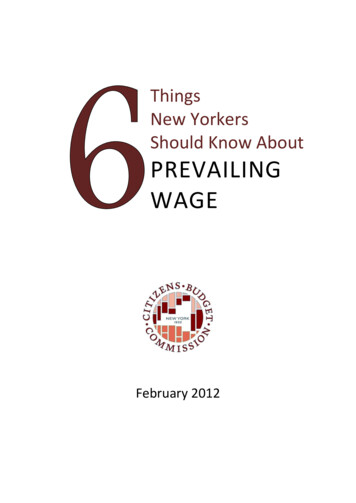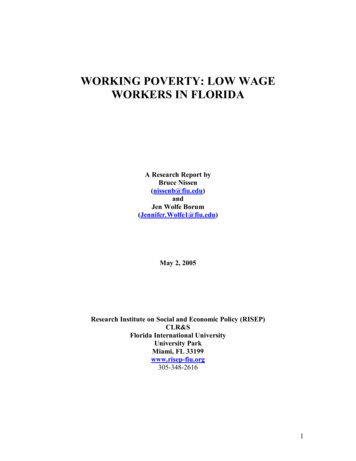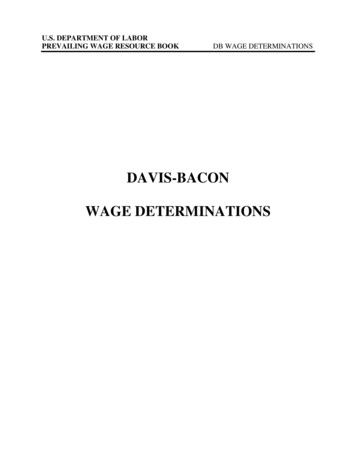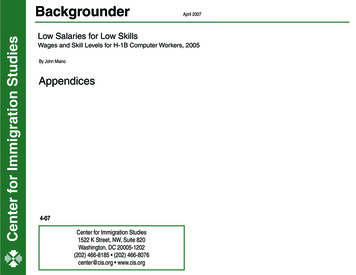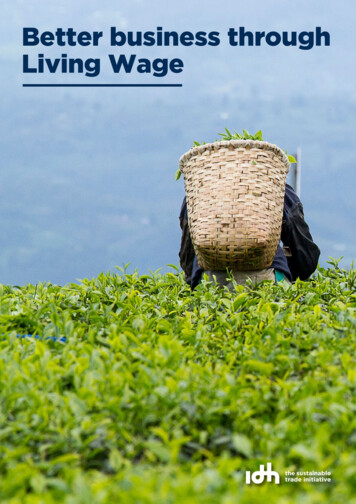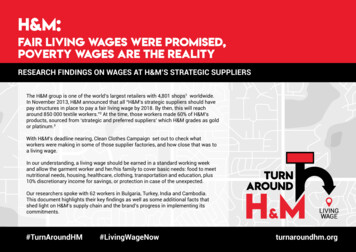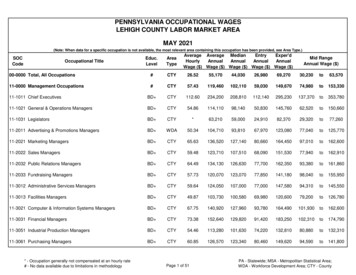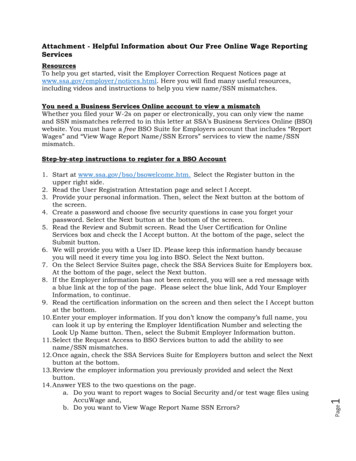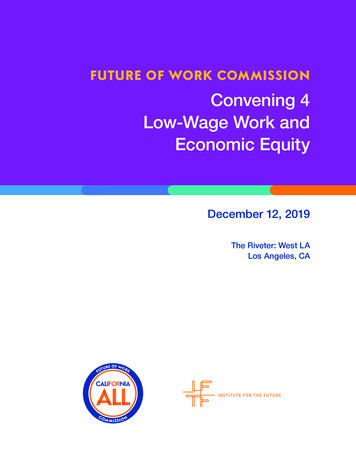
Transcription
FUTURE OF WORK COMMISSIONConvening 4Low-Wage Work andEconomic EquityDecember 12, 2019The Riveter: West LALos Angeles, CAFUTURCOE OF WORKM MIS SIO N
ABOUT THE INSTITUTE FOR THE FUTURE (IFTF) AND ITS ROLEThe Institute for the Future (IFTF) is working with theCalifornia Labor Secretary and larger State Team tocoordinate the work of the Commission. IFTF drawson its over 50 years of research and experience inconvening discussions of urgent future issues to supportthe efforts of the Commission to build a strong vision forthe future of work in the state. IFTF has been a leadingvoice in discussions about the future of work for thepast decade, seeking positive visions for a workforceundergoing transformational change. As a facilitator ofthe Commission’s work, it will help guide the convenings,helping establish the comprehensive understandingnecessary to build a world-class workforce of the future.IFTF will draw on the work of its Equitable Futures Lab toframe these discussions of future jobs, skills, and laborpolicy in terms of creating an equitable economy whereeveryone has access to the basic assets and opportunitiesthey need to thrive in the 21st century.ABOUT IFTFInstitute for the Future is the world’s leading futuresorganization. For over 50 years, businesses, governments,and social impact organizations have depended upon IFTFglobal forecasts, custom research, and foresight trainingto navigate complex change and develop world-readystrategies. IFTF methodologies and toolsets yield coherentviews of transformative possibilities across all sectors thattogether support a more sustainable future. Institute for theFuture is a registered 501(c)(3) nonprofit organization basedin Palo Alto, California. www.iftf.orgFor more information, please contactAnmol Chaddha achaddha@iftf.org*All materials printed in house at IFTF 2019 Institute for the Future. All rights reserved. SR-2112B
FUTURCOE OF WORKM MIS SIO N4 Schedule of Convenings5 Overview of Convening 4:Low-Wage Work and Economic Equity8 Design Principles9 Agenda10 Panelists13 Commissioners19 Supplemental MaterialsFuture of Work Commission Convening 4
SCH E D U L E O F CONVE NINGS1 S eptember 10-11, 2019Overview: The Present and Future State of Work in CaliforniaLocation: Sacramento2 O ctober 10, 2019Technological Change and Its Impact on WorkLocation: Palo Alto3 November 14, 2019Education, Skills, and Job QualityLocation: Riverside4 D ecember 12, 2019Low-wage Work and Economic EquityLocation: Los Angeles5 J anuary 16, 2020Employment and Labor Law in the New EconomyLocation: San Diego6 F ebruary 13, 2020Social Policy, Work, and Economic SecurityLocation: Stockton7 M arch 12, 2020Investors, Capital, and the Future of WorkLocation: San Francisco8 A pril 2, 2020SynthesisLocation: Sacramento4Institute for the Future
OV E RVIE WLOW-WAGE WORK AND ECONOMIC EQUITYDespite the longest economic expansion in U.S. history and very low official unemployment rates byhistorical standards, we now have the highest level of income inequality since the Census Bureau begantracking this measure more than 50 years ago. The economic gains of recent decades have not beenevenly distributed across the income spectrum. The labor market has instead seen negligible real wagegrowth for low-wage workers and a proliferation of low-wage jobs. Economists have largely focusedon a core set of factors to explain these outcomes (though there is considerable debate on the relativesignificance of each): the shift from a manufacturing to a service-based economy, technological changethat has disproportionately benefited those with higher levels of education, competition from trade andthe globalization of economic production, and weakened labor market institutions and policies thatwould otherwise restrain inequality (e.g. declining value of the minimum wage, lower unionization, etc.)We have also seen continued barriers to economic equity,as inequality by race, gender, and immigrant status havepersisted in California. The mechanisms that reproduceinequality in the labor market can include occupationalsegregation, labor market segmentation, spatial isolationand direct discrimination. The California Future of WorkCommission has been challenged to develop an expansivevision of economic equity so that the future of work inCalifornia is inclusive and benefits all Californians.The early stages of technological change may mostdirectly impact low-wage jobs, especially in servicesectors. We are already seeing the incorporationof automation in retail and food service jobs. Therewill be important differences across industries andamong workers, by education level, gender, and othercharacteristics--the most vulnerable workers are likelyto face the most direct impacts. Research suggests thatoccupations that require lower levels of education are themost at-risk to displacement through automation. Beyondjob displacement, technological change is likely to havegreater impact on job quality in low-wage jobs, throughsuch practices as algorithmic management and workplacemonitoring.Many California workers earn wages below what wouldbe required to afford minimum standards of living. Acomprehensive analysis by MIT that determines the cost ofliving based on typical expenses (including food, child care,medical, housing, and transportation) estimates that for afamily with two parents (both working) and two children,each parent would need to earn 16.39/hour in Californiato afford minimum standards of living. The estimated livingwage varies across major regions within the state from 17.19/hour in Fresno to 22.76/hour in San Francisco/Oakland.One in three California workers (35%) earns less than 15/hour. Working full-time, year-round at this wage wouldgenerate an annual income of about 31,000. One halfof all Latino/a workers in the state make less than 15/hour, compared to 23% of white workers. The majority ofthose making under 15/hour are women, though womencomprise just under half of the California’s total labor force.Those making less than 15/hour have lower educationalattainment than the workforce overall; one in five (21%),though, have an associate’s degree (7%) or a bachelor’sdegree (14%). Most workers making less than 15/hourin California (57%) are over age 30. In the Fresno metroarea, 45% of workers make less than 15/hour, comparedto 21% in the San Francisco Bay Area. The vast majority(69%) work full-time.Future of Work Commission Convening 45
LOW-WAGE WORK AND ECONOMIC EQUITYThe largest shares of low-wage workers in Californiawork for employers in retail (16%), food services/restaurants (13%), and health care/social services(12%). The occupations in which the greatest share ofworkers earn less than 15/hour include: agriculturalworkers (82%), food preparation workers (82%), personalcare aides (77%), cashiers (77%), and childcare workers(74%).Wage inequality has grown significantly over the past40 years in the U.S., with hardly any change in wagesfor low-wage workers. From 1979-2018, wages for thetop 10% of workers increased by 45%, after adjusting forinflation. Wages for the median worker increased by 14%.For the bottom tenth of workers, wages have increasedby just 4% since 1979. In fact, all of that growth has takenplace after 2016 (from 1979-2016, wages for the bottomtenth of workers declined slightly by -0.6%). During thecurrent economic expansion since 2009 (the longest in U.S.history), wages have grown by 7% for the bottom tenth ofworkers and by 9% for the top tenth. Even in Silicon Valley,an engine of extraordinary wealth generation, real wagesactually declined for all but the top 10% of earners from1997-2017.Low-wage work can create significant public costs, asmany low-wage workers have incomes that are belowthe eligibility thresholds for social assistance programs.Half of California state expenditures on Medicaid/CHIP andTemporary Assistance for Needy Families (TANF) goes torecipients in working families. A study of state expenditureson social programs estimated that just over half of the 7.3billion in state expenditures on Medicaid/CHIP and TANFin 2009-2011 went to recipients in working families. Acrossthe U.S., 52% of state expenditures on these programswere for recipients in working families.6Institute for the FutureLow-wage workers also confront the challenges ofunpredictable scheduling, income volatility, and thelack of other employment benefits. Irregular schedulingis linked to difficulty in finding childcare and housinghardship. other Low-wage workers are far less likely toreceive benefits like health insurance, retirement, paidvacation, sick leave, and maternity leave. The FederalReserve Board estimated that 36% of low-income familieswent without some necessary medical treatment in 2018.California has a heterogeneous mix of employers,especially by firm size. More than 96% firms in Californiaare small businesses with fewer than 50 employees; 71%have fewer than five employees. About 41% of workersin California are at firms with fewer than 50 employees.Though less than 0.1% of employers in California havemore than 1,000 employees, these largest firms employ15% of California workers.Employers in low-wage industries can face particularcompetitive pressures that keep wages low throughoutan industry. The structure of several industries with alarge share of low-wage work may serve to discourageemployers from acting on their own to increase wages.If a large competitor pays relatively low wages, it canbe difficult for others in the industry to compete withoutlowering wages. This is sometimes described as a ‘raceto the bottom’, as firms begin to compete on labor costs,driving down wages throughout the industry. Some policyinterventions have focused on industry-level standardsto raise the floor to discourage firms from competing onlowering wages, such as the industry-specific minimumwage policy for fast food establishments in New York State.
FUTURCOE OF WORKM MIS SIO NABOUT THE CONVENINGSOME QUESTIONS TO CONSIDERThe fourth convening of the Future of Work Commissiontakes place in Los Angeles, a diverse, global city that facesmany of the demographic, economic and social challengesand opportunities that the state as a whole will confrontin coming years. As with the previous convening, theCommission will hear from external experts in the morning,and the afternoon will be dedicated entirely to discussionamong Commissioners about the substantive work facingthe Commission.1. What floors should be in place to ensure the livelihoodof all California workers (e.g. wages, benefits, workconditions, scheduling, etc)?The convening will begin with a welcome from Los AngelesCounty Supervisor Hilda Solis, who formerly served asthe U.S. Secretary of Labor in the Obama Administrationfrom 2009 to 2013. Manuel Pastor (University of SouthernCalifornia) will provide perspectives on the politicaleconomy of low-wage work and inequality in California.Abel Valenzuela (UCLA) will draw on his research on lowwage work, race and immigrant workers in Los Angelesand beyond, including informal or unregulated work andday laborers. This will be followed by a conversation withthe first set of employers to share insights directly with theCommission. Mark Herbert (Small Business Majority) willprovide perspectives on the problems of low-wage work,as a representative of an organization of small businessowners in California. Pamela Kan (Bishop Wisecarver) willshare insights from a California-based manufacturer.In the afternoon, the Commission will continue the work itbegan at the previous convening to collectively develop ashared understanding of the scope of the Commission’swork and begin considering the criteria and characteristicsof potential solutions.2. What are the key barriers to economic equity facedby workers of color, immigrant workers, and othermarginalized workers in California?3. What strategies or policies could encourage employersto pursue high-road employment and discourage a raceto the bottom by competing primarily on wages?4. What policies or strategies can shape technologicaldevelopment to improve jobs and promote economicequity rather than displacing jobs or exacerbatinginequality (e.g. funding for R&D, incentives and regulationregarding adoption of technology, data collection, etc.)?SELECTED RESOURCESLow-Wage Work in California: Data Explorer. UC BerkeleyLabor Center.Martha Ross and Nicole Bateman. “Meet the low-wageworkforce.” Brookings Institution. 2019.Income Volatility: A Primer. Aspen Institute ExpandingProsperity Impact Collaborative (EPIC). 2016.Drew Desilver. “For most U.S. workers, real wages havebarely budged in decades.” Pew Research Center. 2018.Future of Work Commission Convening 47
DE S I G N PR IN C IPL E SThe Commission collectively developed the following design principles to createand evaluate recommendations.Bold: nothing should be excluded on the basis of political feasibilityForward-Facing: let’s not solve for the last warWork-Adjacent: include work plus housing, transportation, livingContext-Sensitive: take into account implications across gender, race, age, geographyCoalition-Building: bring together multiple stakeholdersPortfolio-Based: easy/fast to hard/long-termScalable: achieve high impactAgile and Iterative: can be prototyped and adapted as neededMeasurable: identify clear areas of potential impactActionable and Practical: grounded in real-world solutions that can be implemented8Institute for the Future
AG E NDATHURSDAY, DECEMBER ilda Solis, Los Angeles County Board ofSupervisors; former U.S. Secretary of Labor10:20am Low-Wage Work and Economic Equity inCaliforniaManuel Pastor, Distinguished Professor ofSociology, University of Southern CaliforniaAbel Valenzuela Jr., Professor of UrbanPlanning, Luskin School of Public Affairs,University of California, Los AngelesModerated by Anmol Chaddha,Institute for the Future11:20amBreak2:35pmBreak2:50pmCommissioner Discussion Part 2Facilitated by Lyn Jeffery, Institute for the Future3:40pmBreak3:50pmCommissioner Discussion Part 3Facilitated by Lyn Jeffery, Institute for the Future4:30pmPublic commentNOTE: The Commission may not discuss ortake action on any matter raised during thepublic comment session, except to decidewhether to place the matter on the agenda ofa future meeting (Government Code sections11125, 1125.7(a)).Mark Herbert, Vice President, California, SmallBusiness MajorityModerated by Lenny Mendonca Chief Economicand Business Advisor; Director, Governor’sOffice of Business and Economic DevelopmentCommissioner Discussion Part 1Facilitated by Lyn Jeffery, Institute for the Future11:30am Employer Perspectives on Jobs andEconomic EquityPamela Kan, President, Bishop-WisecarverLunch5:00pmAdjournFuture of Work Commission Convening 49
PANE L IS T SOPENING ANDWELCOMEHILDA SOLISDR. M ANUEL PASTORSupervisorDistrict 1, Los Angeles CountyDistinguished Professor of SociologyUniversity of Southern California@HildaSolisHilda L. Solis has served on the LosAngeles County Board of Supervisorssince 2014. She previously served as the U.S. Secretaryof Labor in the Obama Administration, as the first Latina inthe U.S. Cabinet. Solis represented a Southern Californiadistrict in the U.S. Congress from 2001 to 2009. As aRepresentative in Congress, she championed expandedaccess to affordable health care, environmental protection,and improving the lives of working families. A recognizedleader on clean energy jobs, she authored the GreenJobs Act which provided funding for “green-collar” jobtraining for veterans, displaced workers, at-risk youth,and low-income residents. Solis became the first womanto receive the John F. Kennedy Profile in Courage Awardin 2000 for her pioneering work on environmental justiceissues, including legislation enacted in California in 1999that was the first of its kind in the nation. Solis graduatedfrom California State Polytechnic University, Pomona,and earned a Master of Public Administration from theUniversity of Southern California.10LOW-WAGE WORK AND ECONOMICEQUITY IN CALIFORNIAInstitute for the Future@Prof MPastorDr. Manuel Pastor is a DistinguishedProfessor of Sociology and AmericanStudies & Ethnicity at the University of Southern California.He currently directs the Program for Environmental andRegional Equity (PERE) at USC and USC’s Center for theStudy of Immigrant Integration (CSII). Pastor holds aneconomics Ph.D. from the University of Massachusetts,Amherst, and is the inaugural holder of the TurpanjianChair in Civil Society and Social Change at USC. Pastor’sresearch has generally focused on issues of the economic,environmental and social conditions facing low-incomeurban communities – and the social movements seekingto change those realities. His current research culminatesin his latest book, State of Resistance: What California’sDizzying Descent and Remarkable Resurgence Meansfor America’s Future. Previous volumes relevant to thefuture of work include: Equity, Growth, and Community:What the Nation Can Learn from America’s Metro Areas,co-authored with Chris Benner (UC Press 2015), JustGrowth: Inclusion and Prosperity in America’s MetropolitanRegions, co-authored with Chris Benner (Routledge 2012),and Staircases or Treadmills: Labor Market Intermediariesand Economic Opportunity in a Changing Economy,co-authored with Chris Benner and Laura Leete (RussellSage 2007).
FUTURCOLOW-WAGE WORK AND ECONOMICEQUITY IN CALIFORNIAE OF WORKM MIS SIO NEMPLOYER PERSPECTIVES ON JOBSAND ECONOMIC EQUITYABEL VALENZUEL A JR.M ARK HERBERTProfessor of Urban Planning,Luskin School of Public AffairsUniversity of California, Los AngelesVice President, CaliforniaSmall Business Majority@AValenzuelaJrAbel Valenzuela is a professor ofChicana/o studies and urban planning and director ofUCLA’s Institute for Research on Labor and Employment.He has authored numerous research articles, books, andreports on immigrant settlement, work, and urban poverty.His research on day labor and immigrant labor marketshave helped frame national public and policy narratives onimmigrant and low-wage workers. Los Angeles occupiesa central focus of his research and teaching, and the cityguides the Institute’s research directions. Valenzuela wasborn and raised in Los Angeles, earned his bachelor’sdegree from UC Berkeley and his M.C.P. and Ph.D. from theMassachusetts Institute of Technology. He has publishednumerous articles and technical reports on low-wageworkers, including co-editing (with Lawrence Bobo, MelvinOliver, and Jim Johnson) “Prismatic Metropolis: Inequalityin Los Angeles” published by the Russell Sage Foundationin 2000, “Immigration and Crime: Race, Ethnicity, andViolence” (with Ramiro Martinez Jr.). He has also publishedin American Behavioral Scientist, Journal of Ethnic andMigration Studies, Annual Review of Sociology, NewEngland Journal of Public Policy, Working USA: A Journalof Labor and Society, International Journal of ComparativeSociology, and Regional Studies.@smlbizmajorityMark Herbert directs Small BusinessMajority’s operations throughoutCalifornia. As Vice President, California, Mark overseespolicy, outreach and development efforts across the statewhile also directing Small Business Majority’s work onresponsible small business lending issues nationwide.Previously, Mark served as the organization’s CaliforniaDirector, Project Manager, and Outreach Manager inCalifornia -- where he developed strong relationshipswith small business owners and business organizationsacross the state. Prior to joining the Small BusinessMajority more than six years ago, he worked for state andfederal lawmakers where he directed business operationsand built relationships with small business owners andkey stakeholders in relation to public policy issues.An entrepreneur himself, Mark runs a small consultingbusiness specializing in volunteer management andorganizational capacity building. He serves on the advisoryboards for the Northern California, San Diego, and ImperialValley Small Business Development Centers networks,which oversee a total of 22 SBDCs in California. Mark alsoserves on Covered California’s Marketing, Outreach andEnrollment Advisory Group.Future of Work Commission Convening 411
PANE L IS T SEMPLOYER PERSPECTIVES ON JOBSAND ECONOMIC EQUITY (CONTINUED)PA MEL A K ANPresidentBishop-Wisecarver@PeekanPamela Kan has served as President ofBishop-Wisecarver (BW) since 1999 andhelps the company leverage its 70 years of experience toprovide proven motion solutions that are expertly designedand delivered to perform, enabling customers to solvetheir toughest industrial automation challenges. Kan’sentrepreneurial vision and commitment to customer servicehelped her lead the company in its first acquisition, aswell as becoming certified in the Bay Area Green BusinessProgram and as a WBENC (Women’s Business EnterpriseNational Council) certified woman-owned business.As one of the few female leaders in the manufacturingindustry, Kan is active in numerous regional and nationaltrade organizations helping to promote manufacturing asa strong career option, as well as STEM-focused studentprograms and mentoring groups for new women businessowners. Kan is the Past Chair of the Executive Committeefor California Manufacturing and Technology Associationand has served on the California Workforce DevelopmentBoard, the Workforce Development Board of ContraCosta County, and is a member of the East Bay AdvancedManufacturing Partnership.12Institute for the Future
FUCOM M I S S I O NE RSTURCOE OF WORKM MIS SIO NROY BAHATDR. SOR AYA M . COLEYVenture CapitalistBloomberg BetaPresidentCal Poly Pomona@roybahatRoy Bahat invests in the future of workas a venture capitalist, with a focuson machine intelligence. Prior to his life as a VC, Bahatfounded start-ups, served as a corporate executive atNews Corp., and worked in government in the office ofNew York City mayor Michael Bloomberg. As the head ofBloomberg Beta, an investment firm with 150 million dollarsunder management, Bahat and his team have invested inareas like automation, data, robotics, media, productivitytools, and many others. Fast Company named Bahatone of the Most Creative People in Business and noted“Bahat is a natural innovator . one of the most candidpeople you’ll ever meet (check out his LinkedIn profile).” Heorganized “Comeback Cities,” where he leads groups ofventure capitalists and members of Congress on bus toursto find the untapped beds of talent and entrepreneurshipin America. He also co-chaired the Shift Commission onWork, Workers, and Technology, a partnership betweenBloomberg and think-tank New America to look atautomation and the future of work 10 to 20 years from now.DOUG BLOCHPolitical DirectorTeamsters Joint Council 7@TeamsterDougDoug Bloch has been political directorat Teamsters Joint Council 7 since 2010.In this capacity, he works with over 100,000 Teamstersin Northern California, the Central Valley, and NorthernNevada in a variety of industries. He was the Port ofOakland campaign director for Change to Win from 2006 to2010 and a senior research analyst at Service EmployeesInternational Union Local 1877 from 2004 to 2006. Mr.Bloch was statewide political director at the CaliforniaAssociation of Community Organization for Reform Now(ACORN) from 2003 to 2004 and ran several ACORNregional offices, including Seattle and Oakland, from 1999to 2003. He was an organizer at the Non-GovernmentalOrganization Coordinating Committee for NortheastThailand from 1999 to 2003.@PresColeyCPPDr. Soraya M. Coley, a veteranadministrator with more than 20 years ofexperience in higher education, became the sixth presidentof Cal Poly Pomona in January 2015. Coley transitionedto Cal Poly Pomona from Cal State Bakersfield, where shewas the provost and vice president for academic affairs from2005 to 2014. She also served as interim vice presidentfor university advancement in 2011–12. Her experienceincludes serving as Cal State Fullerton’s dean of theCollege of Human Development and Community Service,as administrative fellow, and professor and departmentchair for the human services department. She was thesystem-wide provost and vice president for academic affairsat Alliant International University, from 2001 to 2003. Coleyearned a bachelor’s in sociology from Lincoln University,a master’s in social planning and social research fromBryn Mawr, and a doctoral degree in social planning andpolicy from Bryn Mawr. She is married to Ron Coley, Lt.Col. (Ret.) USMC, who after his military service, enjoyed adistinguished career in public service and higher educationadministration, including six years as Senior CountyAdministrator in Orange County, California, and multiplesenior positions at the University of California.LLOYD DEANChief Executive OfficerCommonSpirit Health@LloydHDeanLloyd Dean is chief executive officer ofCommonSpirit Health, a newly creatednational health care system formed by Dignity Health andCatholic Health Initiatives. He is co-chair of the CaliforniaFuture Health Workforce Commission, chair of the Boardof Directors for the Committee on Jobs in San Francisco,and a member of the McDonald’s Board of Directors. Deanholds degrees in sociology and education from WesternMichigan University and received an honorary Doctorof Humane Letters degree from the University of SanFrancisco. A strong advocate for health care reform, hehas been actively engaged with President Obama and theWhite House Cabinet on healthcare issues.Future of Work Commission Convening 413
COM M I S S I O NE RSJENNIFER GR ANHOL MFormer GovernorState of Michigan@JenGranholmJennifer Granholm served two termsas Michigan’s 47th governor from2003 to 2011, and was the Michigan Attorney Generalfrom 1998-2002. As Governor, Granholm led the statethrough a brutal economic downturn that resulted from theGreat Recession and a meltdown in the automotive andmanufacturing sectors. She worked relentlessly to diversifythe state’s economy, strengthen its auto industry, preservethe manufacturing sector, and add new, emerging sectors,such as clean energy, to Michigan’s economic portfolio.After leaving office, Granholm served as an advisor toPew Charitable Trusts’ Clean Energy Program, where sheled a national campaign for clean energy policies. Shealso hosted Current TV’s political news analysis show“The War Room with Jennifer Granholm” and co-authoredA Governor’s Story: The Fight for Jobs and America’sEconomic Future, which tells how Michigan pioneeredways out of an economic storm and offers proven advicefor a nation desperate to create jobs. Currently, Granholmis a contributor to CNN, a Senior Advisor to the progressivepolitical groups Media Matters and American Bridge, ishead of the sustainability practice at Ridge-Lane, and sitson numerous private sector and non-profit boards.L ANCE HASTINGSPresidentCalifornia Manufacturers &Technology Association@lance hastingsHastings has held several leadershiproles at MillerCoors the past 15 years. He servedmost recently as Vice President of National Affairs forMillerCoors. Prior to that he served as Head of Regulatory& Tax Affairs for SABMiller. He also represented MillerBrewing Company and MillerCoors in Sacramento asDirector of State Government Affairs, where he served onCMTA’s Board of Directors. Before his long career as amanufacturing executive Hastings was the Vice Presidentand Director of Government Relations from 1998 to 2003 atthe California Grocers Association. Hastings also workedin the California State Legislature for almost a decadeas a chief consultant, starting in 1989. Hastings has aBachelors of Arts in Economics and a Minor in Government14Institute for the Futurefrom California State University at Sacramento.M ARY K AY HENRY, CO-CHAIRInternational PresidentService Employees InternationalUnion (SEIU)@MaryKayHenryMary Kay Henry is InternationalPresident of the 2 million-member Service EmployeesInternational Union (SEIU), and her leadership is rooted in adeep-seated belief that when individuals join together theycan make the impossible possible. Under her leadership,SEIU has won major victories to improve working families’lives by strengthening and uniting healthcare, propertyservices, and public sector workers with other workingpeople across the United States, Canada and PuertoRico. In 2010, Mary Kay Henry became the first womanelected to lead SEIU, after more than 30 years of helpingunite healthcare workers. By 2015, she was namedone of the 100 most creative leaders by Fast Companymagazine and was included in the top 50 visionariesreshaping American politics by Politico magazine for SEIU’sinnovative leadership in propelling the fight for living wagesembodied in the historic movement known as the “Fightfor 15.” Henry believes that to better fulfill the promise ofa just society America has always aspired to be, we mustfight for justice on all fronts including defending the gainsaccomplished for access to affordable healthcare for allfamilies under the Affordable Care Act, comprehensiveimmigration reform and a path to citizenship for allhardworking immigrant families, and safety and justicein all communities of color across the country.
FUTURCOE OF WORKM MIS SIO NCARL A JAVITSTOM K ALILPresident & CEORoberts Enterprise DevelopmentFund (REDF)Chief Innovation OfficerSchmidt Futures@cjavitsredfCarla Javits is President and CEOof REDF (The Roberts Enterprise Development Fund), apioneering venture philanthropy galvanizing a nationalmovement of social enterprises—purpose-driven,revenue-generating businesses that help people striving toovercome employment barriers get good jobs, keep thosejobs, and build better lives. Through her stewardship, REDFhas invested in 183 social enterprises in 26 states. Thesebusinesses have generated 755 million in revenue andemployed 37,700 people—and counting. REDF’s goal is tosee 50,000 people employed by 2020, contribu
recipients in working families. A study of state expenditures on social programs estimated that just over half of the 7.3 billion in state expenditures on Medicaid/CHIP and TANF in 2009-2011 went to recipients in working families. Across the U.S., 52% of state expenditures on these programs were for recipients in working families.

